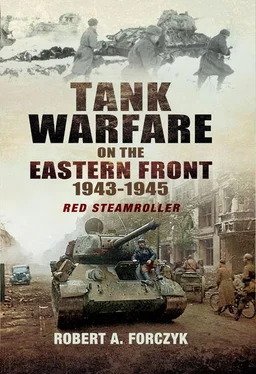In stark contrast to Großdeutschland ’s poor performance, Generalmajor Johann Mickl’s 11.Panzer-Division had done a thorough pre-battle study of the terrain and mission and requested additional pionier support. Although mines disabled at least eight of Panzer-Regiment 15’s tanks, the rest were able to effectively support their infantry and pioniers in the attack against the fortified village of Butovo. Panzer-Regiment 15 also employed a company of attached Flammpanzers to burn out Soviet infantry positions. However, the Panzer-Regiment was caught in the open by Il-2 Sturmoviks twice, which bombed and strafed the formation, inflicting serious losses. Panzer-Regiment 15 assisted Großdeutschland in the capture of Cherkasskoye and also sparred with Akoponov’s 245th Tank Regiment, claiming 10 tanks knocked out. By the end of the first day, 11.Panzer-Division had advanced 7km and had inflicted significant losses upon the 67th Guards Rifle Division’s first line of defence. There is no doubt that the two front-line rifle divisions of the 22nd Guards Rifle Division suffered crippling losses, but the survivors were falling back to the second line of defence held by the 90th Guards Rifle Division on the Pena River. Furthermore, Vatutin gave Chistiakov’s 6 GA the fresh 27th Anti-Tank Brigade and the POZ detachments spent the night of 5–6 July laying more mines in the path of von Knobelsdorff’s armour. Vatutin also alerted Katukov’s 1TA to be prepared to fight a major action on the Pena.
Hausser’s II./SS-Panzerkorps deployed LSSAH and Das Reich against the 151st and 155th Guards Rifle Regiments of the 52nd Guards Rifle Division near the village of Beresov. Hausser’s divisions opted to open their attacks against the Soviet first line of defence primarily with their pioniers and Panzergrenadier-Regiments, supported by their Tigers and assault guns. Soviet mines inflicted considerable damage and, along with anti-tank ditches, caused the German armour to halt, while the pioniers cleared them by hand. SS-Untersturmführer Michael Wittmann’s Tiger was one of two from LSSAH that was immobilized by mine damage. Podpolkovnik Ivan K. Kotenko’s 1008th Anti-Tank Regiment, deployed with 24 76.2mm ZIS-3 anti-tank guns along the road to Bykovka, caused the LSSAH considerable trouble during the breaching operations; 8 StuG IIIs from the Sturmgeschütz-Abteilung were knocked out and the battalion commander was badly wounded. Another Tiger, which bypassed one of Kotenko’s camouflaged guns, was hit in the rear and destroyed. However, the lavish firepower afforded to the Waffen-SS divisions and their gung-ho attitude finally prevailed. Kotenko’s anti-tank guns were picked off one after another until three-quarters of them were destroyed, then two of the 52 GRD’s frontline regiments were overrun. [25]Then the German assault groups overran the divisional artillery and command posts, completely disrupting the defence. Shocked by the rapid demise of the 52 GRD’s first line of defence, Polkovnik Dmitri A. Shcherbakov’s 230th Tank Regiment, equipped with a mix of M3 Grants and M3 Stuarts, was committed to try and slow the Germans and enable the remnants of the 52 GRD to retreat to the second line of defence. Committing obsolescent Grants and Lees against Tigers was suicidal and much of Shcherbakov’s regiment was shot up within 30 minutes. {91} Hausser held most of his armour back on the first day, but the LSSAH still succeeded in advancing more than 12km through the 52 GRD’s defences and was only stopped when it bumped into the 51st Guards Rifle Division in the second line of defence. Vatutin responded by deploying the 28th Anti-Tank Brigade to block LSSAH ’s further advance. The LSSAH ’s remarkable advance was achieved at a cost of 636 casualties. {92} Das Reich was less successful and advanced only 6–8km. On Hausser’s right flank, the Totenkopf chewed its way through the first line of the 375th Rifle Division, but five of its Tigers were immobilized by mines and three StuG IIIs were destroyed. After crossing a mined anti-tank ditch, Totenkopf ’s assault troops encountered T-34s from Polkovnik Viktor G. Lebedev’s 96th Tank Brigade and some Su-122s and Su-76s from the 1440th SAP, resulting in several platoon and company-size skirmishes. [26]By the end of 5 July, Totenkopf had advanced 5km. Altogether, the II. SS-Panzerkorps had suffered 44 tanks or assault guns disabled by mines, including 10 of its 35 Tigers, while personnel casualties were 1,081 (including 214 killed or missing). {93} Losses of pioniers were particularly heavy. On the other hand, the 6 GA had lost its first line of defence more quickly than expected. One of the primary reasons appears to have been the large amount of close air support provided to Hausser’s II. SS-Panzerkorps, which the Soviets noted as inflicting greater damage than German armour.
Breith’s III Panzerkorps, which was supposed to protect Hausser’s right flank, had to cross the Donets River before it could even approach the first line of defence held by the 25th Guards Rifle Corps of Shumilov’s 7 GA. Armee-Abteilung Kempf held a small bridgehead over the Donets at Michailovka, just south of Belgorod, with one bridge standing. Unlike Hoth’s PzAOK 4, Kempf could not really conduct a counter-reconnaissance because of the river, so he opted to conduct counter-battery fire on the evening before Zitadelle ; unfortunately, this consumed much of his ready artillery ammunition just prior to the assault. When dawn approached, the 6., 7. and 19.Panzer-Divisionen began crossing the Donets, first with infantry. There really is no subtle way for a large armoured force to cross a river under the gaze of an alert enemy, and in some ways Breith’s III. Panzerkorps attack resembled the British VIII Corps’ attack over the Orne River during Operation Goodwood in July 1944. Shumilov’s artillery observers spotted the German crossings right away and pounded the far side with volleys of rockets and high explosive, which destroyed the Michailovka bridge and damaged some of the other assault bridges. Without the bridge, Breith’s intent to use the Michailovka bridgehead became impossible and the attack in this sector was aborted. Breith had split up his Tiger battalion, s. Pz.Abt. 503, giving one company to each of his three Panzer-Divisionen – against the recommendation of Guderian to mass this key asset. Amazingly, Breith had put little thought into how these 58-ton heavy tanks were going to cross the Donets, since his pontoon bridges were only rated up to 24 tons. Consequently, the Tigers spent much of the first day sitting out the battle awaiting the pioniers to build a 60-ton bridge. Indeed, none of the German armour was able to cross the Donets until 1030 hours, five hours after the beginning of Zitadelle .
The assault crossing of the 19.Panzer-Division was a near debacle and even once across the river, the pioniers had to clear minefields by hand in broad daylight under enemy fire. Soviet artillery pounded the hell out of the Germans attempting to breach the minefields, inflicting hundreds of casualties. When the Tigers of 2./s. Pz.Abt. 503 finally moved forward, first they ran into a friendly minefield that disabled two Tigers, then ran into uncleared enemy mines which disabled many more; by the end of the day the company had 13 out of its 14 Tigers disabled. The 7.Panzer-Division also suffered badly from enemy artillery, including losing the battalion commander of II./Pz.Rgt. 25. Eventually, the 7. and 19.Panzer-Divisionen were able to advance 3–6km, but 6.Panzer-Divisionen was unable to get its armour across until very late on the first day. Breith’s III. Panzerkorps was hopelessly behind schedule from the start and it is hard to understand how either Kempf or von Manstein failed to appreciate the influence of terrain in this sector. Indeed, much of the German planning for Zitadelle appears to have been made with little regard for terrain or the enemy.
Читать дальше








![John Stieber - Against the Odds - Survival on the Russian Front 1944-1945 [2nd Edition]](/books/405234/john-stieber-against-the-odds-survival-on-the-russian-front-1944-1945-2nd-edition-thumb.webp)



